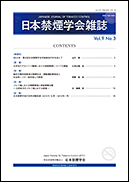
- |<
- <
- 1
- >
- >|
-
[in Japanese]2017Volume 12Issue 4 Pages 72
Published: August 30, 2017
Released on J-STAGE: September 23, 2017
JOURNAL FREE ACCESSDownload PDF (191K)
-
Chie Taniguchi, Takahiro Tabuchi, Izumi Sezai, Tomoyasu Hirano, Satomi ...2017Volume 12Issue 4 Pages 73-81
Published: August 30, 2017
Released on J-STAGE: September 23, 2017
JOURNAL FREE ACCESSAim: To identify nurses’ role and practice in smoking cessation therapy (SCT) in Japan.
Methods: We distributed a self-administered questionnaire to the nurses or physicians of 750 clinics and 350 hospitals using a random sampling technique. Questionnaire items included nurses’ role in SCT, time of nurses’ counseling and whether the nurses who were engaged in SCT at the institutions received education on smoking cessation intervention.
Results: The response rate was 25.9%. SCT included nurses’ counseling in 64% of the medical institutions. Among these institutions, 64% of the institutions provided individualized nurses’ counseling for patients’ problems that occurred after the cessation. Only 57% of institutions answered that the nurses had received skilled training for smoking cessation intervention. The institutions in which the nurses received skilled training for smoking cessation intervention showed significantly higher success rate (odds ratio: 2.33, p = 0.017) than institutions in which nurses did not receive such skilled training.
Discussion: It is necessary to establish standardized guidelines for nurses’ counseling in SCT and to use effective materials such as a leaflet to be given to patients for smoking cessation intervention.
View full abstractDownload PDF (1050K) -
Asuka Nagano, Tsukasa Ohnishi, Mutsumi Iwasaki, Ayaka Yamamoto, Masaak ...2017Volume 12Issue 4 Pages 82-88
Published: August 30, 2017
Released on J-STAGE: September 23, 2017
JOURNAL FREE ACCESSObjective: We investigated the contributing factors for clinical response to the nicotine patch (Nicotinell® TTS®), a smoking cessation aid, and established a scoring system for predicting the clinical response to smoking cessation therapy.
Methods: We investigated clinical factors from the medical records of patients treated with nicotine patches from the smoking cessation clinic. We separated the patients (n = 70) into the success group and the failure group according to the outcome of the 12-week treatment, and then analyzed the clinical factors from medical records.
Results/Findings: The 12-week failure rate was 47.1% (33/70 patients). Multivariate stepwise logistic regression analysis revealed that TDS (Tobacco Dependence Screener) and psychiatric disease in underlying disease were significant factors that independently contributed to a negative response, with odds ratios of 1.736 (per point of TDS score), and 5.587 (no vs. yes, psychiatric disease), respectively. A predictive index (PI) of clinical response to the nicotine patch in patients was calculated using the regression coefficients of these two factors as an integer, and the index was significantly higher for the failure group than for the success group.
Conclusion: The obtained PI may represent an appropriate scoring system for predicting the responses to nicotine patches in these patients.
View full abstractDownload PDF (509K)
- |<
- <
- 1
- >
- >|